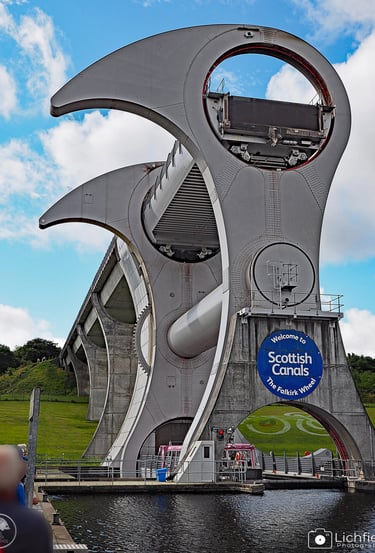
The Falkirk Wheel And The Kelpies: Days Out Review
Team Hedgehog take a trip up north to the Falkirk Wheel and The Kelpies, read how we got on
Garry Llewellyn
9 min read
Heading North To Falkirk Wheel and The Kelpies.
Are you ready for an adventure? Join us on a captivating journey from the Midlands to Scotland, where we will explore the awe-inspiring The Falkirk Wheel and The Majestic Kelpies. We discuss our route and, and delve into their fascinating creation process. Get ready to be amazed!
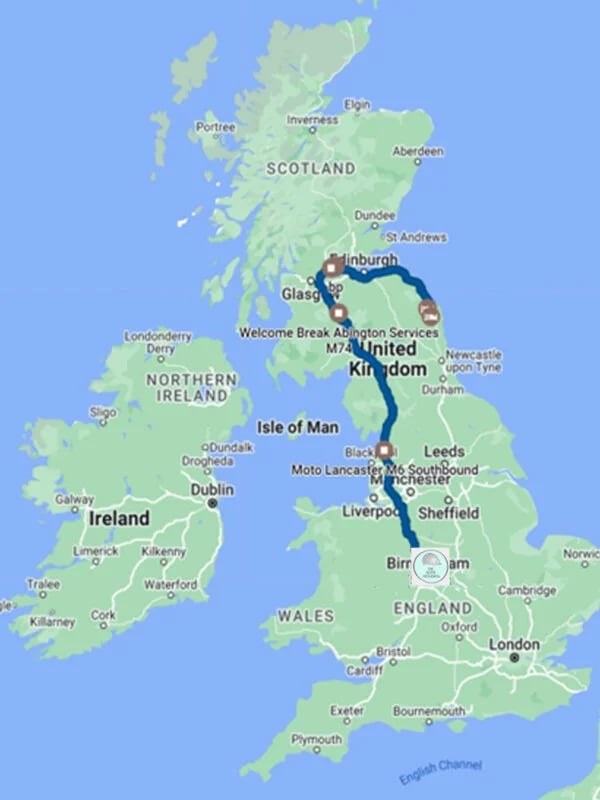

Map data ©2023 GeoBasis-DE/BKG (©2009), Google, Inst. Geogr. Nacional
In the summer of 2023 we decided to embark on a road trip from Hedgehog HQ in Staffordshire, to Scotland, to visit the Falkirk Wheel and then on to Northumberland.
The first leg of our journey north, takes us up the M6 to the Lancaster Services – with its iconic Grade 2 listed hexagonal concrete tower ‘The Pennine Tower’
Apart from the tower, Lancaster services have few redeeming features. It is an oppressive grey building inside and out. The kind you want to get out of as soon as you set foot inside. It could double as a set for ‘The Last Of Us’, but at least it had a Greggs, so that was nice.
The Pennine Tower
At the time when the Lancaster Services were built, advertising to road users was banned. The owners (Rank) needed something that would grab drivers’ attention.
The mid 1960’s were full of optimism, more people were travelling, and the romance of air travel had swept the nation. So, no better structure to build than an Air Traffic Control inspired tower, designed by Architects T.P Bennett & Sons. Completed in 1965, the tower became an instant landmark with the top hexagonal section featuring a fully functioning restaurant. Weary travellers could stop to grab food and look at stunning views over the Pennines. Sadly though, it didn’t make a profit and Rank shut it down. Various attempts to use the space failed, and the tower has sat empty for around 30 years. The tower became a listed building in October 2012.
Nowadays the tower is a shadow of its former glory, the 2016 light ivory repaint is looking so weathered, one cannot tell the building is painted – rust and dirt cover the sides. The listed status may have preserved the building from demolition, but it also makes returning the building into some useful function stupidly expensive.

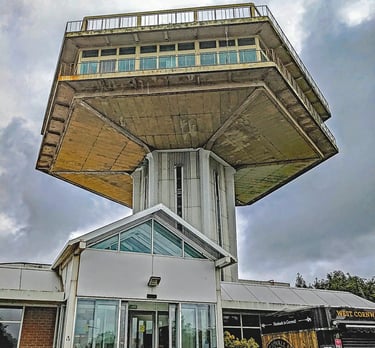
Having made our way from the zombie apocalypse in waiting, we re-join the M6 and head ‘Up North’. The M6 giving way to the M74(M). We pass through picturesque countryside, leafy green hedgerows, rolling hills and wind turbines, you could be forgiven for thinking we are heading to Cornwall, not Scotland. The beauty of it all was quite impressive, Soon, all this greenery gives way to 1950’s suburban sprawl – our route taking us randomly through a housing estate in Camelon. Nine traffic islands and several narrow streets later, we saw a sign for ‘The Wheel’ (yes, I have Michael McIntyre in my head every time I say The Wheeeeel).
That gave us a choice to make. Park at the large free car park closer to the top section of the wheel or drive a few more minutes to the visitor centre nestled at the base of the wheel. As time was ticking and we had a boat trip booked, we headed for the visitor centre. As we arrived we could see the car park was built on the side of a steep hill, with the visitor centre at the base. Once parked we descended the path down to the visitor centre, anticipation building as to what we would find…
The Falkirk Wheel
You would be forgiven for thinking it is a relic from the Victorian era, reminiscent of a bygone time, however, the Falkirk Wheel is a culmination of 21st-century technology. Every inch of the Falkirk Wheel oozes meticulous craftsmanship and precision. The massive industrial looking structure weighs over 1,800 metric tons, a clue to the strength and stability required to support the volume of water needed, and the boats that use it.
So why does The Falkirk Wheel exist?
This very tall structure was built to solve a momentous challenge – to reconnect two historically significant canals: the Forth and Clyde Canal and the Union Canal. Both waterways once played essential roles in industrial Scotland, but over time, they fell into disuse and faded from prominence, along with the 11 locks which would take nearly a day to pass through.
As the turn of the millennium approached, an idea was presented that would reignite the canals’ vibrant spirit – create a link that would create a seamless passage for boats, barges, and those looking to journey through Scotland’s waterways. So after a period of consultation the design was chosen, and with the Falkirk Wheel’s creation, a new era of connectivity was formed.
As we strolled through the visitor centre, we found a small exhibit that showcased the Falkirk Wheel design and inner workings. Then a ticket desk with the obligatory shop, plus a café and the loos. It’s quite an airy building with a glazed front, providing light and a glimpse of the outside. Walking outside we found ourselves staring at a canal basin with the Falkirk Wheel to our left. That’s when we could see the sheer scale of the wheel, a truly extraordinary experience. The battleship grey structure towering 35meters (111Ft) high. The wheel is shaped not so much as a wheel, but as a pair of clawed gondolas. The claw shape helps to stabilise the structure. It looks massively over engineered for a what is effectively a canal bridge (14,000 bolts and 45,000 bolt holes) and that’s because it is designed to resist the Scottish storms, last for at least 100 years and deal with massive stresses on the steel as it operates (each gondola is capable of holding 500 tonne of water and boats).
The Falkirk Wheel certainly stands out against a Scottish blue summer sky.
The Wheel Experience
We had timed our journey from middle England to Falkirk to perfection. We only had a short wait for our allotted timed boat trip slot. While waiting, the wheel started moving and what is surprising is just how silent the movement is. It uses a series of cantilevers, electronics, and hydraulics to make the movement happen, using less energy than it takes to boil a kettle in the processes. Its awe inspiring seeing the two claw gondolas gently spin around and swap places. After only a few minutes a boat appeared at the docking pit, at the base of the wheel. This was our boat.
Making full use of the canal basin the boat span round and docked ready for us to board. It was a typical tourist boat, like ones you would see on any popular river. On the outside it had large, glazed windows so tourists can look out, on the inside rows of seating. Having joined the other tour patrons, chosen our seat and listened to the safety briefing, the boat set off.
We entered the boat pit at the base of the Wheel, the staff tied the boat up and hydraulic lifts activated sealing us into the gondola. Soon we realised that we were moving. The ground giving way to a view of the horizon. The movement was so very gentle. We arrived at the top docking station, and everything happened in reverse, the hydraulic lifts lowered, allowing the Union Canal to meet our boat. Once untied we began our tour. This top section of the Wheel is covered by a series of metal hoops. They look striking and give this section a sense of identity, as they emulate the idea of going through a tunnel.
Speaking of tunnels, the stretch of the canal we are on is called the Union Canal Extension. Built in 2002 as part of the Millennium project, this extension passes through specially constructed, 175-metre-long, Roughcastle Tunnel. As we entered the tunnel we noticed the curvature of the roof was covered in a rainbow of coloured lights, changing patterns as we passed through the tunnel. We have since found out that the lights are motion activated, and spring into life when a person approaches (by boat, foot or cycle). The light patterns also change to suit the time of day, year, or occasion – how cool is that?!
Once through the tunnel, the boat continued for a few minutes until we came to a lock basin and the captain did a skilful 360 turn, and we made the return journey back to the wheel.
The whole journey lasted about 45 minutes, whilst not the longest boat tour we have ever been on, the commentary was interesting and informative, and the star of the show was the wheel itself.
We disembarked from the boat and had a good walk around the site. There are other things to do at the location, such as a children’s play area and some electric small boats to hire (which children can go on) as well as longer canal walks should time allow. It is a great spot for photography too.
Falkirk Wheel Gallery
The Falkirk Wheel is a marvel of engineering.
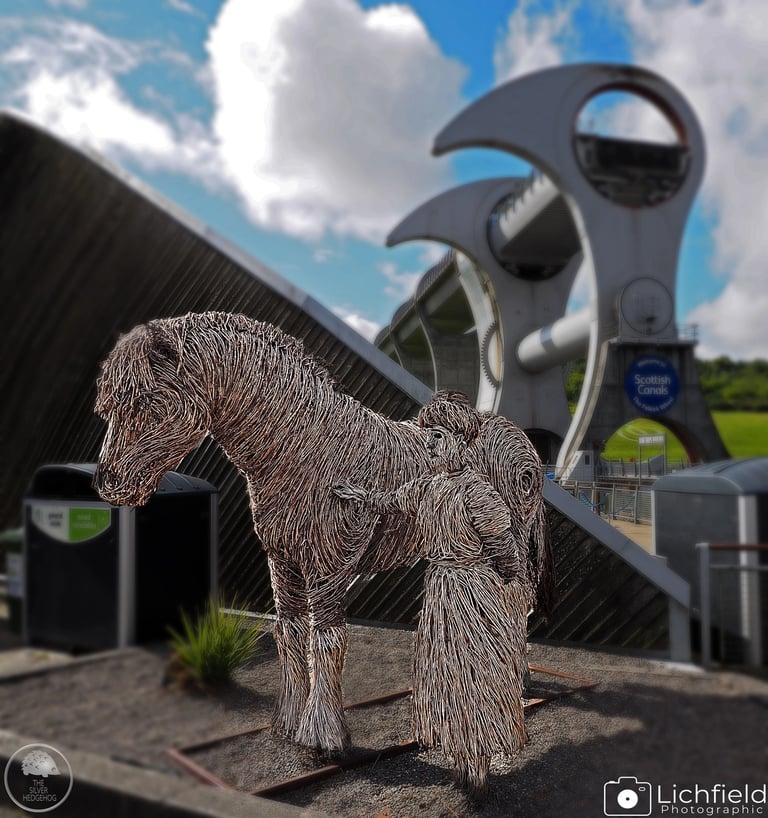
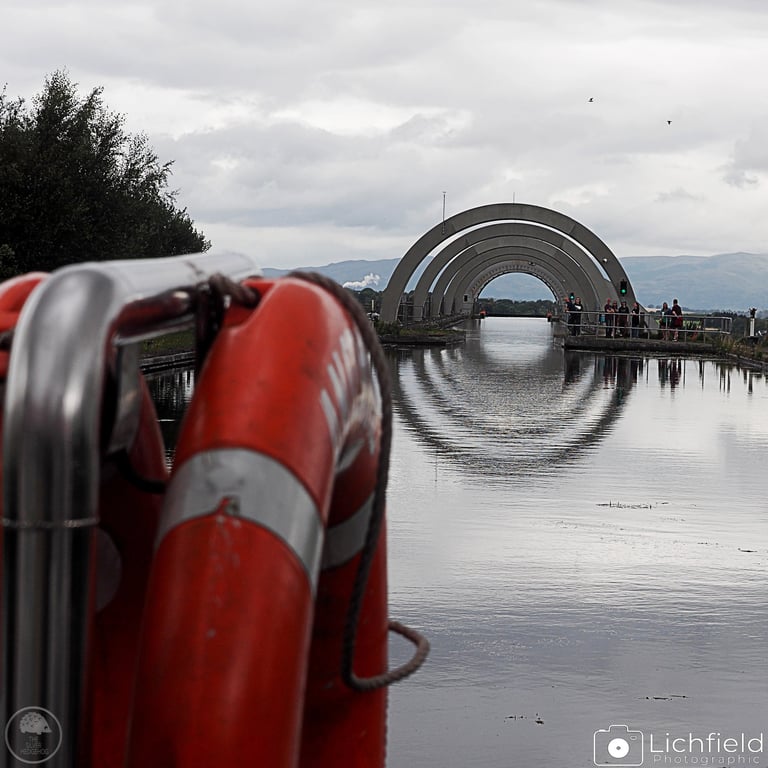
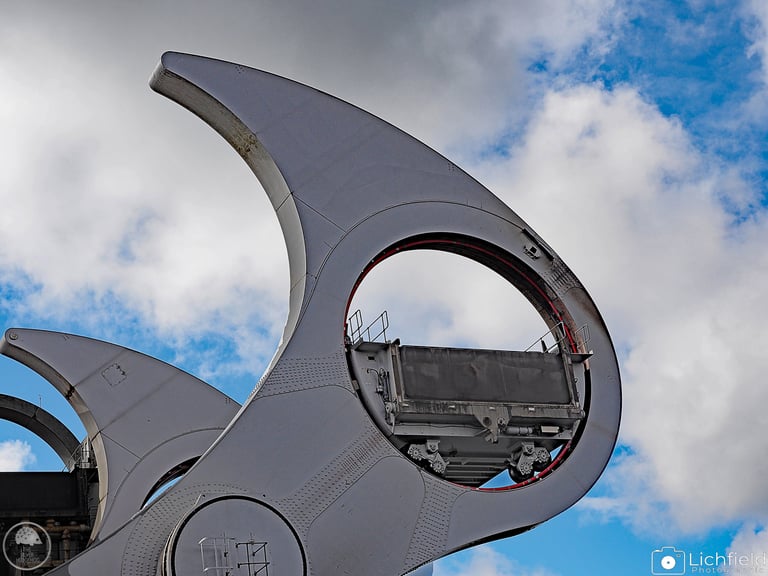
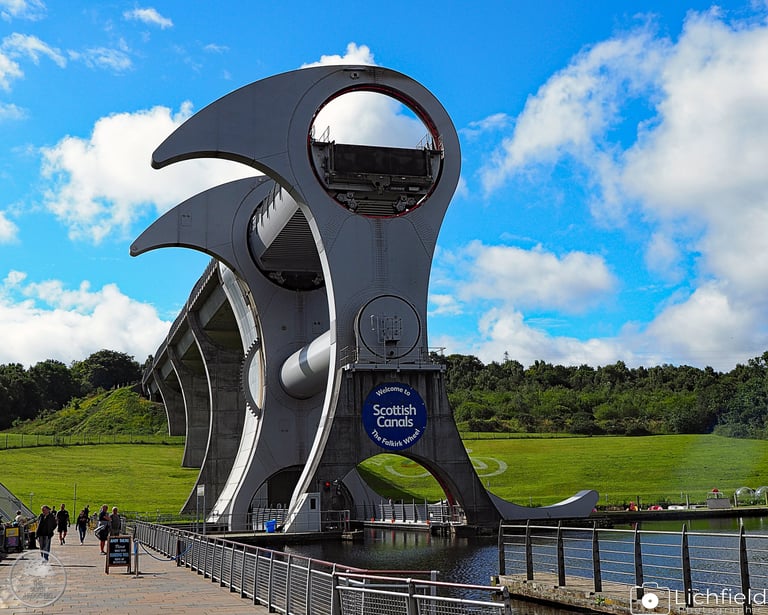

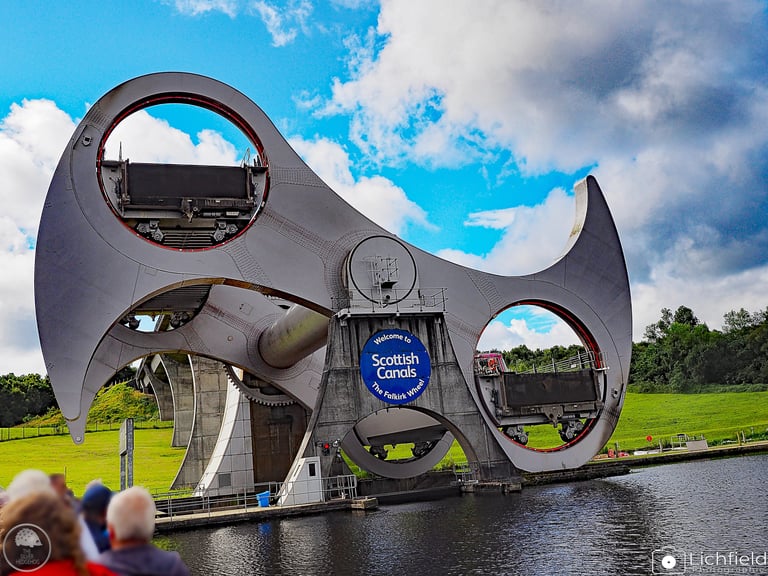
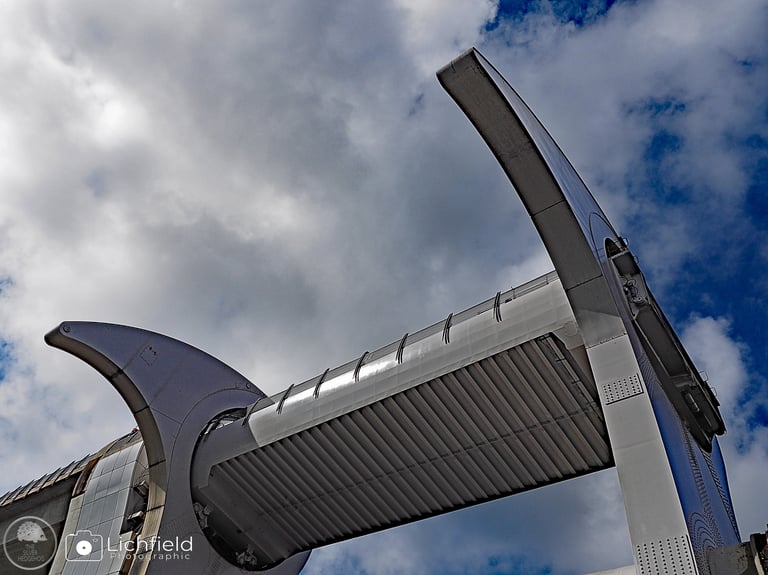







The Kelpies
After a picnic in the car, we decided to leave the Falkirk Wheel and head towards the Kelpies as they were nearby, and it seemed to be the done thing. We underestimated how busy this next venue would be and struggled to park. Eventually we were directed to a car park known as the ‘Helix Car Park Hub’, glad to see it had some toilets and the Kelpies seemed not too far a walk, as we could see a glimpse of the horses over a hill.
When we arrived at the Helix Visitor Centre, we were greeted by the two magnificent sculptures. Each one standing tall and proud. Their shimmering stainless steel colossal horse heads towering 100 meters high. They are so huge; they make visitors look like the size of ants!
Envisaged as a place to bring communities in Falkirk together, thanks to Sculptor Andy Scott, The Kelpies became the largest equine sculptures in the world, each weighing over 300 tonnes.
So Why The Kelpies?
In Scottish folklore and mythology, the Kelpies are vengeful spirits, usually depicted as black horses. Found near locks and water sources, legend has it a Kelpie would lure travellers to their death. Some historians think that the Celts created stories of the Kelpies to keep their young away from dangerous water sources, especially during a raging Scottish storm.
An Unforgettable Visit
Sculptor Andy Scott has captured the essence of this Scottish folklore. Not using black steel, but instead, a shimmering stainless steel – turning this water spirts from a dark warning to a message of hope for Scotland. You can’t help but feel wonder and excitement when looking at these statues.
We only get to see their heads, but the shop has illustrations of what is going on with the rest of the horses ‘under the water’. They are swimming against a current, their legs thrashing wildly. It’s a powerful image and helps make the statues come to life in your mind. As we walk around them, we cannot help but marvel at the artistry and the stories they represent.
The creation of these statues was meticulous and that shows in the finished sculptures. Taking photographs and zooming into them, you can see the stainless-steel plates have been carefully cut, shaped and welded together, forming the intricate details of the horse heads. The result is a testament to the skill and craftsmanship of the team involved in bringing these majestic creatures to life – unfortunately though the company that manufactured them has now gone into administration.
"Echo the great beasts that work among us
unbridled in this kingdom between canal and firth
here to harness the river
Carry each weary traveller
Bow down your strong heads to taste the water
Stretch up your long necks to face the sun "
— Jim Carruth
The Kelpies Gallery
A tale of myths and legends

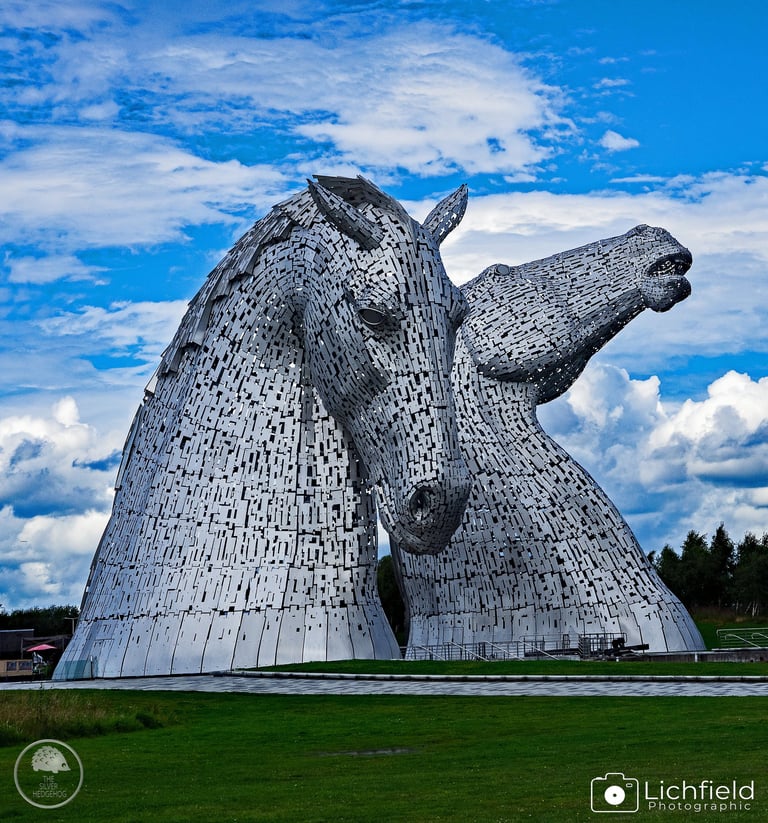

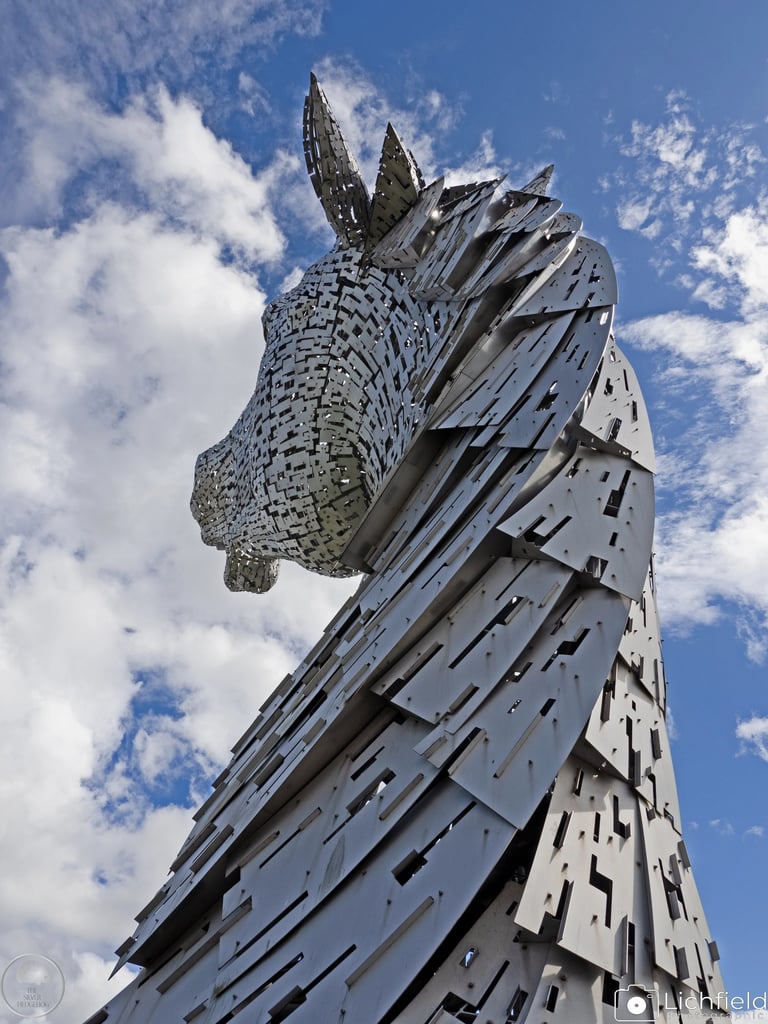
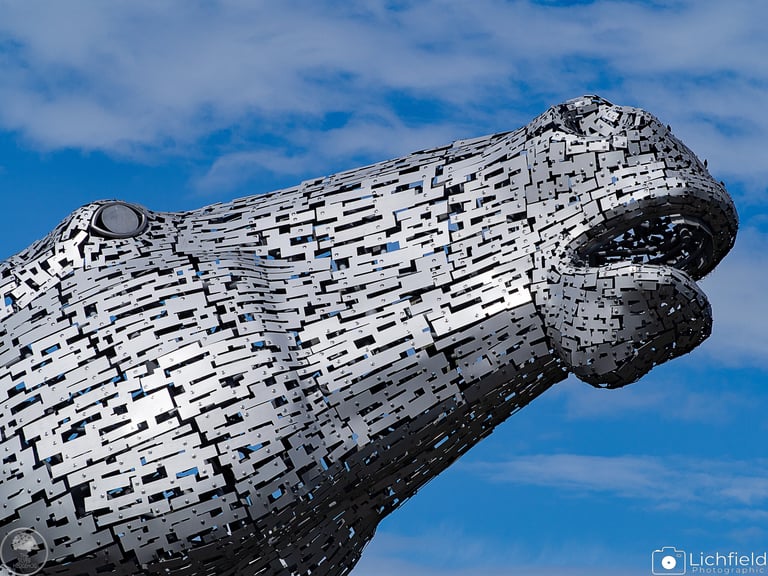

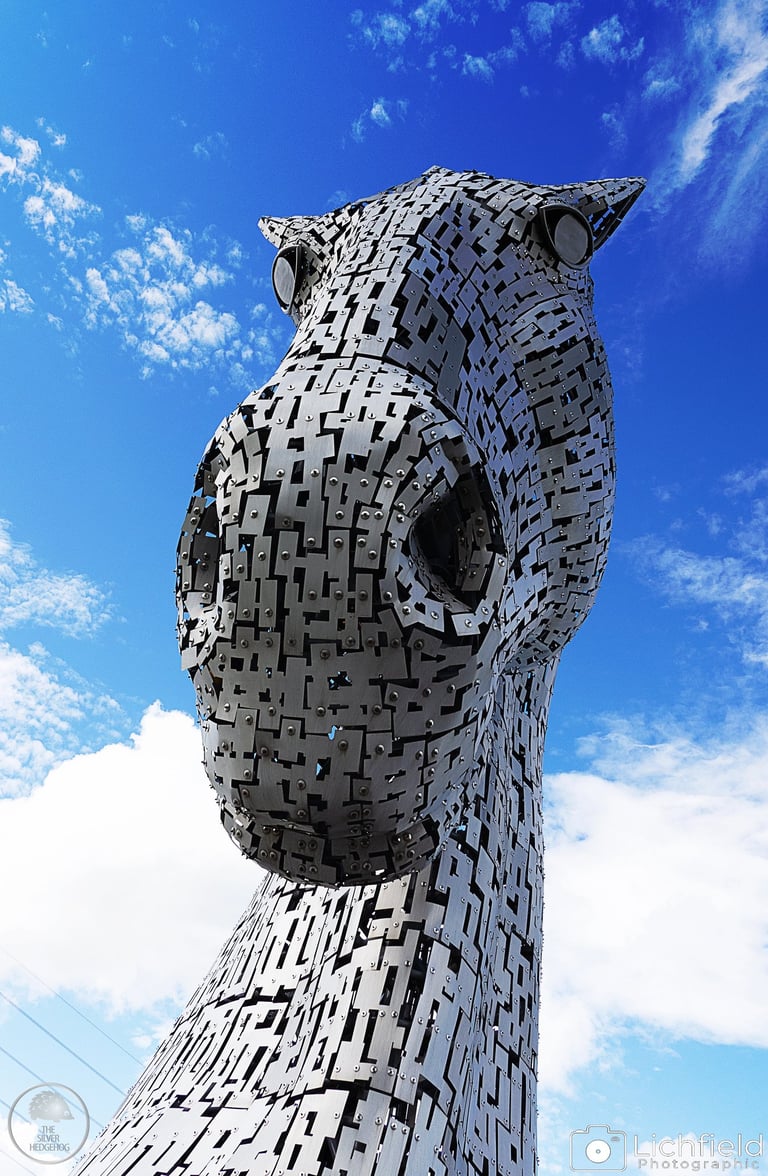









Timisien Luminarium Overall Thoughts...
Visiting the Falkirk Wheel and The Kelpies is a journey that takes us into the heart of Scottish mythology and artistic brilliance. From the scenic drive through picturesque landscapes, to the awe-inspiring sight of the wheel and the colossal sculptures, every moment is filled with wonder and awe.
The Kelpies stand as a testament to the power of art and storytelling, captivating visitors from all corners of the globe. So, if you find yourself in Scotland, do not miss the opportunity to witness the magic of the The Falkirk Wheel and The Majestic Kelpies. It’s an experience you won’t forget.
The Silver Hedgehog Rating: 10 'Must Visit'
Value For Money
🦔🦔🦔🦔🦔🦔🦔🦔🦔🦔
Visit Experience
🦔🦔🦔🦔🦔🦔🦔🦔🦔🦔
Attraction Facilities
🦔🦔🦔🦔🦔🦔🦔🦔🦔🦔
If you find yourself in Scotland, do not miss the opportunity to witness the magic of the The Falkirk Wheel and The Majestic Kelpies. It's an experience you won't forget!
Words: Garry
Editor: JJ
Photos Lichfield Photographic
Review Extra's
You might like our other Days Out Reviews.
About Us
The Silver Hedgehog is a review website dedicated to providing in-depth reviews. We aim to review a wide variety of Films, Entertainment, Family Days Out and Special Features.
Indie Filmmakers, Publicists and Small Business Owners
Indie filmmakers, publicists, creatives, and Small Business owners interested in coverage
please email screeners or inquiries to submissions@thesilverhedgehog.com
©️Garry Llewellyn 2020-2026 All text is the property of Garry Llewellyn and TheSilverHedgehog.com.
Text should not be reproduced in whole, or in part, without permission from the author.
All images, unless otherwise noted, are the property of their respective copyright owners.





